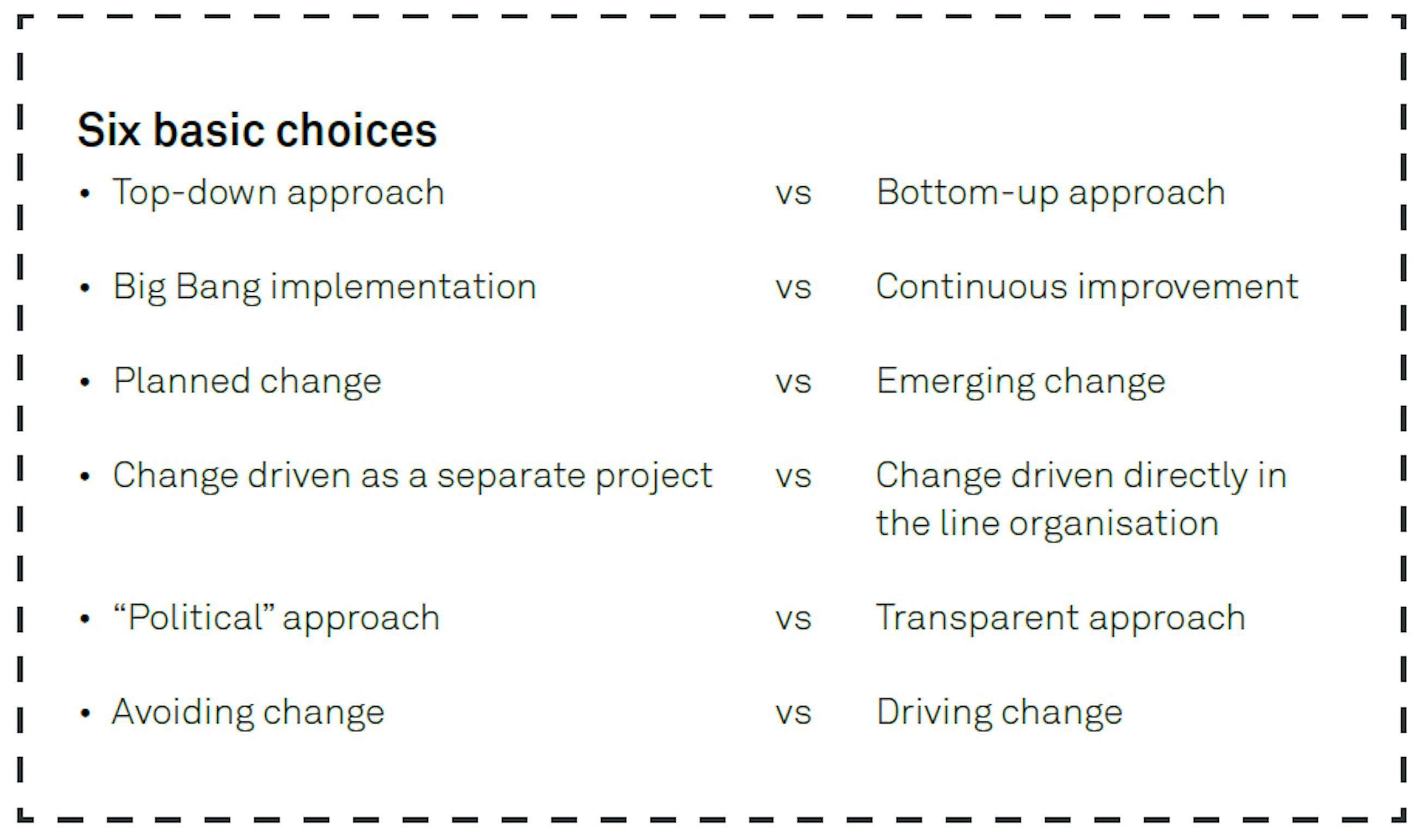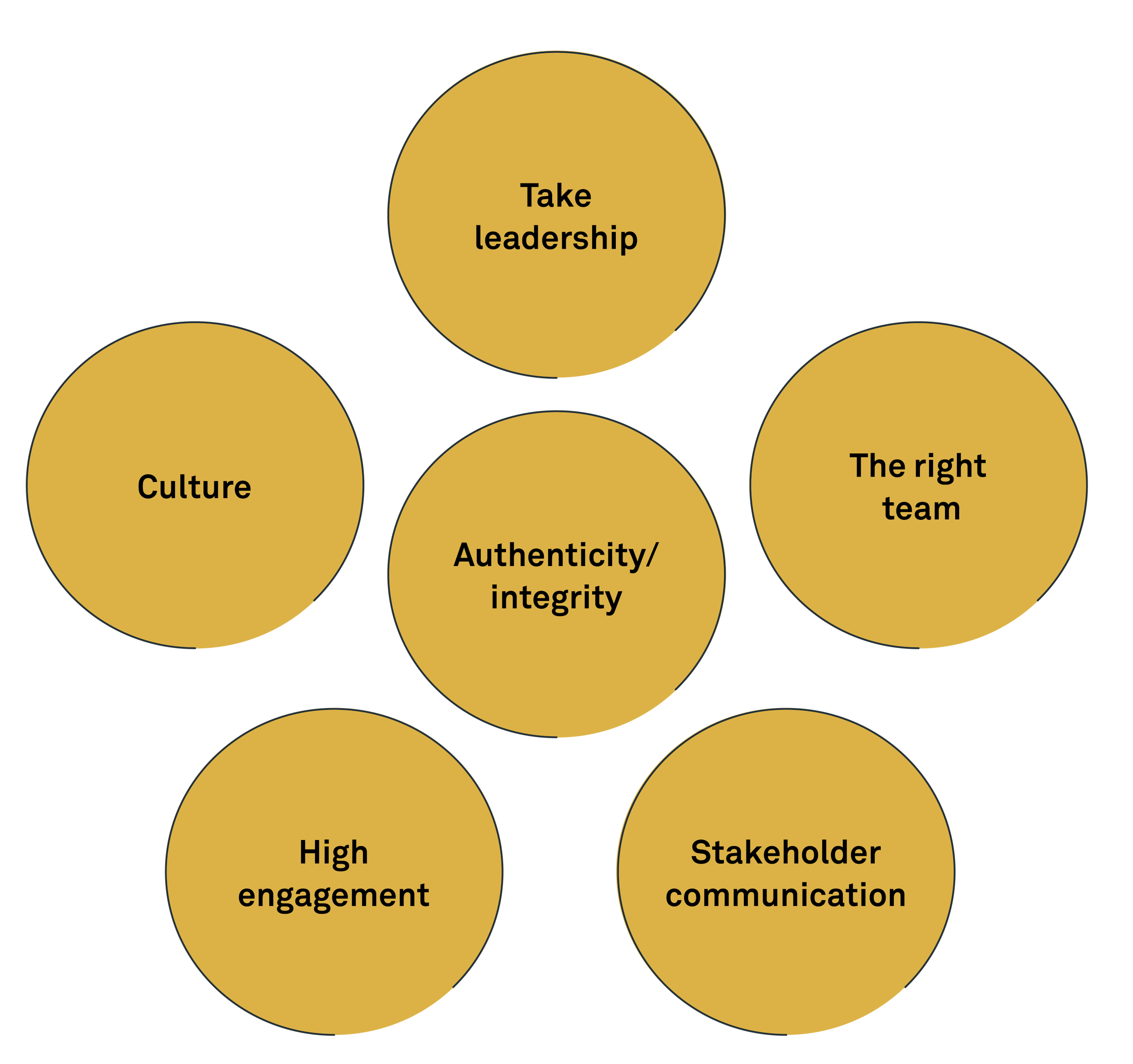Implement has investigated whether CEOs use a set framework to guide them when driving change. The general conclusion was that they do not. One notable exception was that 15-20% of the CEOs stated that they use Lean and "continuous improvement" as basic models when working with change.
13 November 2015
We asked 25 CEOs and top executives (from here on referred to simply as CEOs) in private companies and public organisations to share their point of view on the subject of change. The conversations were conducted in the spring of 2014, and we asked the CEOs to reflect on leading change.
The fact that so many CEOs do not use a set model obviously does not mean that they act on a totally ad hoc basis. The majority of the CEOs seemed to have an intuitive idea of how to approach and organise a change process. In fact, they use a combination of the following factors:
- Previous experience from extensive exposure to change in different managerial/leadership positions
- Personal values that influence how they manage the change (for instance, the view on top-down vs engagement and participation)
- An assessment of the situation at hand and of the possibilities and limitations pertaining to that situation
- An understanding of the impact of the organisational culture on how to succeed with change.
“No, we do not have a model. If we had a model, we might be able to drive change faster than we actually do. Our guiding principle is communication. We put great emphasis on getting the middle managers on board.”
In other words, there are many ways in which to conduct successful change management (but also many ways in which to conduct less successful change management).
Six basic choices made by the CEOs to drive change
Based on the interviews, we identified six choices which are considered by the CEOs when deciding on how to approach a change initiative (note; the six choices are the sum of reflections from all interviews). The categories are not mutually exclusive but overlap each other in different ways.
Top-down approach vs bottom-up approach
None of the CEOs advocated a true bottom-up approach, meaning a change initiative that is initiated in the line organisation and given attention and resources from the top management, eventually becoming the focus for the whole organisation. Given that our target group were CEOs, this perspective was not a surprise. However, the CEOs did have different views on WHO to involve and WHEN.
Some of the CEOs stated that a top-down approach, starting with a small circle of people who create the first draft of a change plan, was the preferred approach. Here, the top group normally outlines the desired state with a vision and objectives. The next step is to bring the draft plan to a larger group of managers to be elaborated on and “to get them on board”.
“Change must be driven by the top management. We make most of the big decisions ourselves. We have the necessary competence and insight.”
“We set the boundaries in the executive team. It is the 3-year strategy with quantitative and qualitative targets. We decide how hard we push and in what order we will proceed. When this is done, it is time to involve the next layer of managers.”
One of the advantages of using this approach is that it gives the initiator control of the overall decision and of the process. One of the disadvantages is that it creates a situation where a small group of people need to convince a larger group of people to join a change initiative that they were not part of initiating or (really) developing. The result is often the well-known lack of full buy-in.
The majority of the CEOs stressed the importance of involving a larger circle of people at an early stage to create the change plan. They see the advantage of involving others, before they make up their own minds, in order to take advantage of people’s competences, experience and ideas. Many CEOs talked about involving a group of 50 – 100 managers at an early stage.
“You need to know, where you are going, and then get everybody with you. Change is not created if it only comes from the top. You really need to get everybody with you.”
“All my work with change is based on people. To come to a decision in an organisation as big as this company, you need to include at least 100 people. They are your primary target group as a change leader.”
Big Band implementation vs continuous improvement
Some of the CEOs (15 – 20%) had a clear preference for a continuous improvement approach. To them, the word “change” was perceived as somewhat negative, and their focus was instead on sustaining a continuous process of development or improvement. Often, these CEOs use Lean ways of working and Lean management as their framework for constant change with the aim of creating a “change culture” in the organisation:
“I do not like the word change; it implies that something is wrong. I prefer using the word development. We work with Lean management and continuous improvement. It is easier to get commitment for smaller changes in shorter sequences.”
On the other hand, many of the change challenges described during the interviews were not possible to predict or handle with a continuous improvement approach. Usually, these are change initiatives coming from the top of the organisation, driven by challenges in the surrounding world or by major internal strategic shifts (turnarounds, transformations etc.) and often with a clear beginning and end date.
“We had to do everything at once, because our financial performance was so bad. And if I had to do it all over again, I would do it the same fast way. During change, there is always a risk that we shift focus from what we really should be doing, so you need to come back to your core business as soon as possible.”
Planned change vs emerging change
There was a clear preference towards a planned approach among the CEOs. The following components were most often mentioned in connection with this approach:
- A detailed overall plan. Vision and objectives for the desired state as well as of the present state. Overall “work streams” for how to move from A to B, including actions, responsibilities and time.
- In order to get buy-in on the overall plan, the desired state needs to be described in a compelling way,i.e. both from a corporate perspective and from an employee perspective. Creating a narrative for the desired state and the transformation to get there is one of the key communication challenges during the change process.
- A process where the overall company plan is communicated and cascaded in the line organisation. The next levels break down objectives and actions to own function and create own plans.
- Clear KPIs to allow follow-up on progress of execution on an aggregated and distributed level. Several CEOs underlined the importance of continuous follow-up and the communication and transparency of the results
- The management needs to stay on top of the change process, even though the responsibility for the implementation has been delegated. The change initiative needs to be a permanent issue on the agenda
- Support to the line managers who have been given the role as change leaders with training and tools from central dedicated resources.
“We have a very detailed plan for how to implement the change. Who is responsible for each part and how we will measure the impact. Without the measurement, it is hard. We need to break it down at an individual level and then measure and follow up.”
Change driven as a separate project vs change driven directly in the line organisation
How do the CEOs organise the change process? We see two main approaches. The first approach is change organised as a specific project, where the line organisation gets involved during the implementation phase.The second approach is a change assignment given directly to the line organisation.
The planned approach mentioned above (C) seems to have a lot in common with the approach to organise change as projects. Projects are especially suitable for developing something – a new work process, a new system, a new organisation etc. A dedicated group of people get the assignment to prepare and develop the desired change and, in a later phase, to implement said change in the line organisation. The benefits for the CEOs are obvious:
- Possible to give a clear assignment and a structure for governance in the form of a steering group
- Clear targets and actions and a clear responsibility for the execution
- Follow-up based on KPIs throughout the process.
“We decided to work with our change activities in the form of an integration project. We had several sub- projects for different parts of the integration. One of my closest colleagues was the project leader. We, then, manned the different sub-projects with people from across the two companies.”
Note that the planned approach for driving change can also be applied, when the responsibility for planning and implementing change is given directly to the line organisation. Some CEOs commented that there are changes where the planned project-oriented approach may have limited value. This could be the case when the goal is to change mindsets, behaviour, culture and values. These are changes that take longer time and require a very high degree of “participation sensitivity” along the way.
"Political" approach vs traditional approach
The importance of communication throughout the change process to get everybody “on board” has been a recurring theme in all the conversations, but also the difficulty in succeeding with the communication. Several CEOs talked about transparency as a key quality of their change communication – for them, transparency means:
- No hidden agenda, being open in terms of background, motives and aspirations
- Continuously measuring the impact, when change is implemented, being open about the results and using them as leverage for the continuous transformation.
“We chose a communication strategy that was transparent. We told everybody what we knew, and what we did not know. We even provided our suppliers, competitors and industry organisation with information about what we were doing.”
A few of the CEOs talked about the importance of understanding and being able to play the “political game” in the organisation. From time to time, this might result in the need for a more tactical approach. The political game often results in positioning and indirect communication, and it can be hard to understand what different people really think. What you see and what you hear is not necessarily what you get.
Avoiding change vs driving change
Approximately 15 % of the CEOs interviewed talked explicitly about avoiding change. We found this interesting. One viewpoint was that there are too many unnecessary changes carried out in organisations.For instance, when a new CEO takes over, it is almost inevitable that a reorganisation will soon take place, followed by a period of disruption, stress and uncertainty. In many instances, this reorganisation is not necessary, but is, according to some of the CEOs, mainly a way for the new executive to show decisiveness.
Another point of view is that in a relatively stable market and slow-moving industry, it can be a success factor not to change and instead streamline the efficiency of operations over time.




